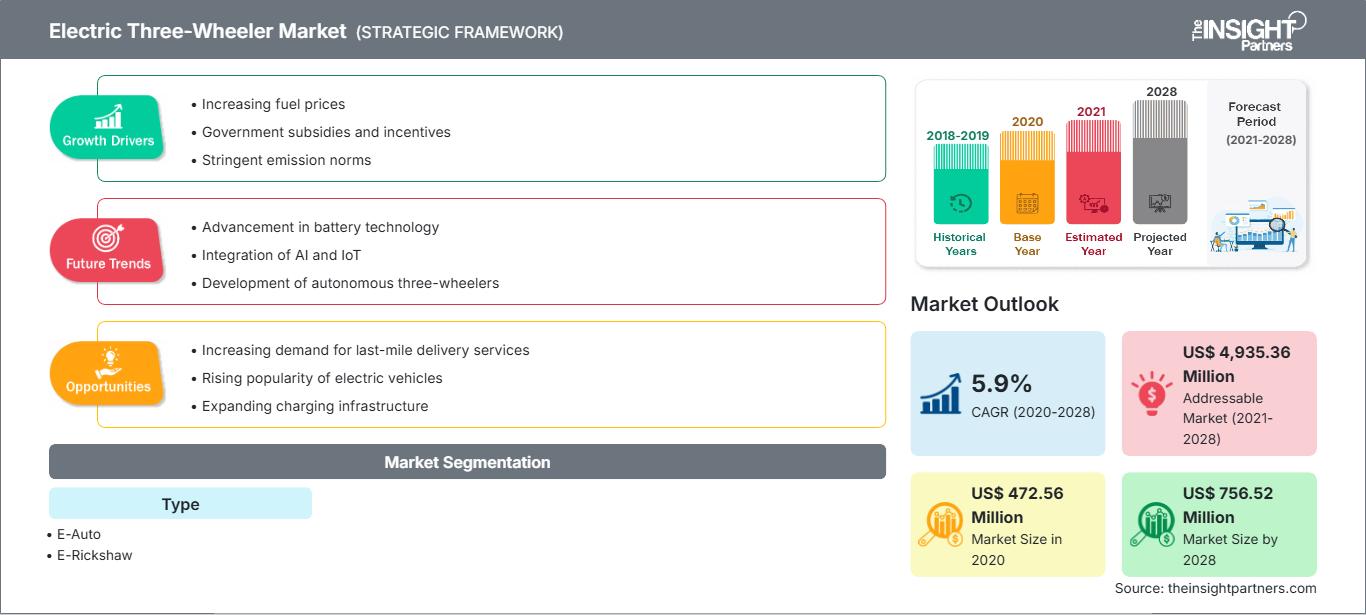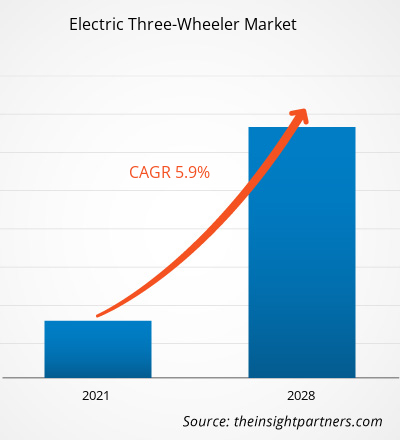Il mercato dei veicoli elettrici a tre ruote è stato valutato a 472,56 milioni di dollari nel 2020 e si prevede che raggiungerà i 756,52 milioni di dollari entro il 2028; si prevede una crescita a un CAGR del 5,9% dal 2021 al 2028.
I veicoli elettrici a tre ruote sono ampiamente utilizzati per il trasporto di passeggeri a destinazione e per il trasporto di merci. Questi veicoli a tre ruote funzionano con motori elettrici alimentati da batterie ricaricabili. Le batterie possono essere ricaricate presso una stazione di ricarica elettrica o qualsiasi altro punto di ricarica. Molti paesi a basso e medio reddito in tutto il mondo hanno un tasso di utilizzo più elevato di veicoli a tre ruote, inizialmente alimentati da motori a combustione interna (CI). Tuttavia, la maggior parte di questi veicoli a tre ruote con motore a combustione interna è diventata inefficiente e obsoleta. Ciò ha portato i produttori ad aumentare la spesa in ricerca e sviluppo di veicoli elettrici a tre ruote. Inoltre, i veicoli elettrici a tre ruote sono molto popolari nelle aree urbane e suburbane, soprattutto per il trasporto di un numero limitato di passeggeri e merci compatte in tempi brevi. Alcuni dei fattori chiave che guidano la crescita del mercato dei veicoli elettrici a tre ruote sono le severe norme e normative governative in materia di controllo dell'inquinamento, la crescente consapevolezza degli effetti nocivi delle emissioni dei veicoli diesel e a benzina e la crescente accettazione dei veicoli elettrici. Poiché benzina e gasolio sono risorse esauribili, le persone hanno già iniziato a pensare ad altre possibili alternative. I veicoli elettrici a tre ruote hanno iniziato a sostituire i veicoli a benzina e diesel. Il costo medio di manutenzione e funzionamento dei veicoli elettrici a tre ruote è sostanzialmente inferiore rispetto ai veicoli convenzionali. Tuttavia, il peso elevato della batteria e la ridotta autonomia sono alcune delle preoccupazioni che i produttori di veicoli elettrici a tre ruote devono affrontare. I veicoli elettrici a tre ruote percorrono circa 125-130 km con la batteria completamente carica, mentre i veicoli convenzionali percorrono circa 200-220 km con il pieno di carburante.
L'APAC ha dominato il mercato dei veicoli elettrici a tre ruote nel 2020. L'India è uno dei maggiori azionisti del mercato dei veicoli elettrici a tre ruote nella regione. L'industria dei veicoli a basse emissioni nel paese sta crescendo rapidamente grazie alle iniziative favorevoli dei governi e alla solida presenza di produttori come Mahindra & Mahindra, Atul Auto, Piaggio e Lohia Auto. Il programma "Faster Adoption and Manufacturing of Hybrid and Electric Vehicles II" (FAME II), con un budget di 1,4 miliardi di dollari, investirà 1,19 miliardi di dollari per consentire sconti iniziali sull'acquisto di veicoli elettrici e 1,9 milioni di dollari per promuovere l'implementazione di infrastrutture di ricarica. Per soddisfare la domanda, queste misure andranno a beneficio di 0,5 milioni di veicoli elettrici a tre ruote.
Personalizza questo rapporto in base alle tue esigenze
Potrai personalizzare gratuitamente qualsiasi rapporto, comprese parti di questo rapporto, o analisi a livello di paese, pacchetto dati Excel, oltre a usufruire di grandi offerte e sconti per start-up e università
Mercato dei veicoli elettrici a tre ruote: Approfondimenti strategici

-
Ottieni le principali tendenze chiave del mercato di questo rapporto.Questo campione GRATUITO includerà l'analisi dei dati, che vanno dalle tendenze di mercato alle stime e alle previsioni.
L'epidemia di COVID-19 ha gravemente interrotto la catena di approvvigionamento e la produzione di apparecchiature elettroniche, compresi i componenti hardware dei veicoli elettrici a tre ruote. Sulla base dell'emergenza del virus COVID-19 in tutto il mondo, seguita da scenari di lockdown, gli esperti del settore automobilistico hanno previsto che il settore avrebbe dovuto affrontare almeno un quarto di ritardo nella catena di approvvigionamento delle apparecchiature elettroniche. È probabile che l'industria delle apparecchiature elettroniche e automobilistica riprenda il suo ritmo subito dopo la revoca delle varie misure di contenimento da parte dei governi, il che contribuirebbe a rilanciare l'economia. Si prevede che la produzione di apparecchiature elettroniche e prodotti per l'automotive aumenterà a partire dal 2021, con un ulteriore impatto positivo sulle apparecchiature elettroniche e sulla produzione automobilistica, compresi i componenti hardware dei veicoli elettrici a tre ruote.
Approfondimenti di mercato: aumento dei livelli di gas nocivi, costi di gestione e accettazione di tecnologie più pulite
L'aumento dei livelli di gas nocivi, i costi di gestione e l'accettazione di tecnologie più pulite sono tra i principali fattori che contribuiscono alla crescita del mercato dei veicoli elettrici a tre ruote. L'adozione di veicoli elettrici può ridurre drasticamente le emissioni di inquinanti nell'ambiente, migliorando così la qualità dell'aria. Per ridurre al minimo le emissioni di gas serra derivanti dalla combustione di carburante, gli enti regolatori di tutto il mondo stanno offrendo agevolazioni fiscali e incentivi per aumentare l'adozione di veicoli ecocompatibili. Quasi tutti i principali paesi hanno annunciato sussidi e incentivi finanziari per invogliare i produttori a produrre più veicoli elettrici a livello locale. Inoltre, crediti d'imposta e sconti stanno spingendo molti utenti locali ad acquistare veicoli elettrici e probabilmente porteranno almeno il 60% circa di veicoli ecologici sulle strade entro il 2020, riducendo così le emissioni di carburante e la dipendenza dai prodotti petroliferi. Gli enti regolatori di Cina, India, Corea del Sud, Indonesia e Bangladesh hanno implementato diversi programmi per incrementare le vendite di veicoli elettrici a tre ruote. Ad esempio, nel marzo 2018, il Ministero dell'Industria Pesante e delle Imprese Pubbliche indiano ha lanciato la Fase II del programma FAME India, che ha ricevuto un sostegno finanziario complessivo di 1,39 miliardi di dollari. Questa fase mira a sostenere 500.000 veicoli elettrici a tre ruote; 55.000 autovetture elettriche a quattro ruote; 7.000 autobus elettrici; e 100.000 veicoli elettrici a due ruote attraverso sussidi. Questa fase del programma FAME mira a creare un'adeguata infrastruttura di ricarica pubblica per promuovere l'adozione di veicoli elettrici tra le masse. Con questo, il Ministero dell'Industria Pesante e delle Imprese Pubbliche prevede il coinvolgimento e la partecipazione attiva di un'ampia gamma di stakeholder, tra cui le Imprese del Settore Pubblico (PSE) e le agenzie governative.
Approfondimenti di mercato basati sulla tipologia
Il mercato dei veicoli elettrici a tre ruote, per tipologia, è segmentato in e-auto (alta velocità) e risciò elettrici (bassa velocità). Il segmento dei risciò elettrici ha guidato il mercato nel 2020. I risciò elettrici sono veicoli elettrici a tre ruote sottodimensionati e hanno una capacità della batteria inferiore rispetto ai veicoli elettrici.
Lo sviluppo di prodotti e le iniziative di mercato sono le strategie comunemente adottate dalle aziende per espandere il proprio portafoglio prodotti. Piaggio & C. SpA, Terra Motors Corporation, Kinetic Green Energy & Power Solutions Ltd., LOHIA AUTO INDUSTRIES e Mahindra Electric Mobility Limited sono tra i principali attori che implementano strategie per ampliare la base clienti e acquisire una quota significativa nel mercato globale dei veicoli elettrici a tre ruote, il che, a sua volta, consente loro di mantenere il proprio marchio. Di seguito sono riportati alcuni dei recenti sviluppi chiave:
- Nell'ottobre 2020, Mahindra Electric Mobility Ltd ha annunciato il lancio del suo nuovo modello di veicolo cargo elettrico a tre ruote, Treo Zor, in India. Basato sulla collaudata piattaforma Treo, il veicolo cargo sarà disponibile in 3 varianti: pick-up, furgone per le consegne e pianale.
- Nel febbraio 2018, Mahindra & Mahindra Ltd e LG Chem hanno annunciato una collaborazione nel campo della tecnologia avanzata delle batterie agli ioni di litio.
Le tendenze regionali e i fattori che influenzano il mercato dei veicoli elettrici a tre ruote durante il periodo di previsione sono stati ampiamente spiegati dagli analisti di The Insight Partners. Questa sezione analizza anche i segmenti e la geografia del mercato dei veicoli elettrici a tre ruote in Nord America, Europa, Asia-Pacifico, Medio Oriente e Africa, America meridionale e centrale.
Ambito del rapporto sul mercato dei veicoli elettrici a tre ruote
| Attributo del rapporto | Dettagli |
|---|---|
| Dimensioni del mercato in 2020 | US$ 472.56 Million |
| Dimensioni del mercato per 2028 | US$ 756.52 Million |
| CAGR globale (2020 - 2028) | 5.9% |
| Dati storici | 2018-2019 |
| Periodo di previsione | 2021-2028 |
| Segmenti coperti |
By Tipo
|
| Regioni e paesi coperti |
Nord America
|
| Leader di mercato e profili aziendali chiave |
|
Densità degli operatori del mercato dei veicoli elettrici a tre ruote: comprendere il suo impatto sulle dinamiche aziendali
Il mercato dei veicoli elettrici a tre ruote è in rapida crescita, trainato dalla crescente domanda degli utenti finali, dovuta a fattori quali l'evoluzione delle preferenze dei consumatori, i progressi tecnologici e una maggiore consapevolezza dei vantaggi del prodotto. Con l'aumento della domanda, le aziende stanno ampliando la propria offerta, innovando per soddisfare le esigenze dei consumatori e sfruttando le tendenze emergenti, alimentando ulteriormente la crescita del mercato.

- Ottieni il Mercato dei veicoli elettrici a tre ruote Panoramica dei principali attori chiave
- E-Auto (alta velocità)
- E-Rickshaw (bassa velocità)
Profili aziendali
- Goenka Electric Motor Vehicles Private Limited
- Piaggio & C. SpA
- Terra Motors Corporation
- Kinetic Green Energy & Power Solutions Ltd.
- LOHIA AUTO INDUSTRIES
- Bodo Vehicle Group Co. Ltd.
- Nobe Cars
- Mahindra Electric Mobility Limited
- E-Tuk Factory BV
- JIANGSU KINGBON VEHICLE CO., LTD
- Analisi storica (2 anni), anno base, previsione (7 anni) con CAGR
- Analisi PEST e SWOT
- Valore/volume delle dimensioni del mercato - Globale, Regionale, Nazionale
- Industria e panorama competitivo
- Set di dati Excel
Report recenti
Rapporti correlati
Testimonianze
Motivo dell'acquisto
- Processo decisionale informato
- Comprensione delle dinamiche di mercato
- Analisi competitiva
- Analisi dei clienti
- Previsioni di mercato
- Mitigazione del rischio
- Pianificazione strategica
- Giustificazione degli investimenti
- Identificazione dei mercati emergenti
- Miglioramento delle strategie di marketing
- Aumento dell'efficienza operativa
- Allineamento alle tendenze normative






















 Ottieni un campione gratuito per - Mercato dei veicoli elettrici a tre ruote
Ottieni un campione gratuito per - Mercato dei veicoli elettrici a tre ruote